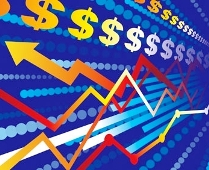 The devil for once doesn't lie in the detail. A closer look at the GDP data for the July-September period does not reveal any hidden inconsistencies that could take the shine off the impressive 7.9 per cent growth. Instead, it gives more reason to cheer.
The devil for once doesn't lie in the detail. A closer look at the GDP data for the July-September period does not reveal any hidden inconsistencies that could take the shine off the impressive 7.9 per cent growth. Instead, it gives more reason to cheer.
For one, growth was not primed by government cash transfers like salary hikes and NREGA payments alone. Gross fixed capital formation (investment in lay terms) picked up sharply in this period compared to the previous quarter.
Measured against the same period last year, investments grew by 7.3 per cent in the second quarter of this fiscal year compared to 4.2 per cent in the first. Its share in GDP increased substantially from 31.6 per cent to 34.7 per cent.
The up-tick in investments deserves close attention since business cycle recoveries are typically accompanied by a sharp rise in capital spending.
To take an example, in 2002-03, the first year of recovery of the previous business cycle (that culminated in the boom years of 2006 and 2007), investment perked up by 10.5 per cent after a phase of negligible growth.
If the traction in investments visible in the second quarter data sustains, it could put the economy back on a higher growth trajectory earlier than most analysts predict -- perhaps as early as the middle of 2010.
Surprisingly, the pick-up in investments is yet to get reflected in the demand for domestic credit. Non-food or commercial credit grew by a meagre 7.4 per cent in the April-November period this year compared to 14.4 per cent during the same period last year.
This discrepancy can be explained by a number of things. It is possible that the GDP statistics for the second quarter essentially reflect a rise in infrastructure spending, the bulk of which is funded by the Budget and does not rely much on bank finance.
Alternative sources of finance that compete with domestic bank credit have also picked up. These cost less than domestic loans and private firms might just be exploring these options before turning to local banks.
External commercial borrowings, for instance, revived from June this year after a lull of about five months. Gross inflows of ECBs were a healthy $6.5 billion between June and September compared to just $2.7 billion between January and March. Indian companies also 'privately placed' a significant amount of bonds and shares with institutional investors.
Going by the Reserve Bank of India data, these added up to a hefty Rs 70,000 crore in the first half of 2009-10 compared to Rs 36,000 crore (Rs 360 billion) in the first half of last fiscal.
However, a full-blown recovery in investment is not possible without the help of domestic banks and domestic credit. Local bankers have been talking about a slow increase over the last couple of months in the demand for term loans.
If the demand for local credit increases and the central bank simultaneously tightens monetary policy to thwart inflation, interest rates are likely to rise. The price of higher growth is likely to be higher borrowing costs in 2010, both for firms and individuals. Unfortunately, in economics, there is no free lunch.






